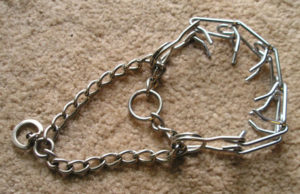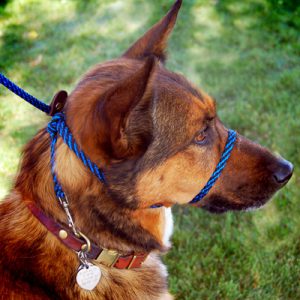Using prong collars for dogs at times can be a bit controversial. There are many people that feel prong collars work great for overaggressive dogs, untrainable dogs and dogs that pull too hard when walking.
Then there is the other side of the scope that feel prong collars are cruel and torturous collars that should never be used on dogs. They feel that prong collars inflict pain and possibly injury of your dog.
Since you are researching this topic, it would make me think that you are trying to decide which is the best dog collar for the active dog you have. I will discuss what exactly a prong collar is, how they work, the potential problems with prong collars, and my experience using prong collars.
Table of Contents
What Is A Prong Collar For Dogs?
A prong collar will have a control loop, that is a chain where the leash is attached to. Around the collar, there are fang shaped metal links, or prongs with blunt points that go towards your dog’s neck. When the collar is pulled, the prongs pinch the loose skin of your dog’s neck.

Prong Dog Collar
The prong collar is applying pressure points to your dog’s skin. They are designed to correct behavior by putting even pressure all the way around the dog’s neck.
Most people that are using a prong collar, choose this collar because they have a hard time trying to control their dog. It might be that your dog is pulling when walking, your dog gets aggressive when he sees other people or animals, or you just generally can’t control your dog.
How To Use A Prong Collar – Proper Fit Of Prong Collar
A prong collar is designed to correct a behavior or get your dog’s attention. It should be one quick tug on the leash to provide discomfort or get your dog’s attention, and direct them in the expected behavior. It is very similar to using a shock collar on your dog. The concept is the same. Quick pain to get your dog to do what is expected of them.
The prong collar isn’t intended for your dog to have constant pressure around their necks. The collar also isn’t intended to remain on your dog when you aren’t walking or training them. The prong collar shouldn’t be considered your dog’s regular collar with your dog’s tags attached. Prolonged wearing could cause sores and injury.
Prong collars need to be properly fitted to avoid injury to your dog. The collar should sit high on your dog’s neck, just behind their ears. The fit should be snug, so prong links can’t shift to the front of your dog’s neck where they could pinch your dog’s trachea.
Do Prong Collars Work?
That depends. If what you want from your prong collar is for your dog not to pull you around the neighborhood, depending on your dog, it will probably work. If what you want from your prong collar is for your dog to become a better walker all the time, no the prong collar will not work.
By using a prong collar you are usually getting your dog to do what you want, but only because your dog is trying to avoid pain. You are teaching your dog that if they don’t pull, they won’t have pain.
Let me give you an example. Several decades ago I had a Doberman Pincher that I just sort of inherited when she was about 3 years old. She was the sweetest dog ever, but when she was younger, she never got any training and I don’t believe that she really ever went for a walk on a leash. Her biggest accomplishment was bolting through the door whenever possible and running as fast as she could.

Using a harness helps control your dog when walking
This was because she was growing up in a college house with 4 guys and none of them ever took her for a walk or gave her any exercise.
Fast forward to several years later, and I am trying to walk this Doberman. The only thing she understood, was going as fast as you can, because you never know when you are going to get out for exercise again. She came outfitted with a choke chain collar and a prong collar.
When I tried to walk Toby, it was a mad dash, even with a choke chain or a prong collar on her. She weighed 86 pounds and I weighed 120 pounds. It didn’t matter to her that she would be choking or if the prongs were digging into her neck. She was dragging me around the neighborhood no matter what, since she never learned to walk properly.
From this experience, I feel that choke chains or prong collars don’t work for dogs that aren’t properly trained how to walk on a leash. If you don’t teach your dog what the proper behavior is, the bad behavior will continue, since they don’t know what is expected of them. You will be forced to continually correct your dog by giving it a good yank to get their attention.
Alternatives To Using A Prong Collar
Positive training is the best method to use to teach your dog to be a good walker. It not only will create a closer bond with you and your dog because of the amount of time that you will have to spend together, but it will help your dog know what is expected of them, and both of you will enjoy your outdoor time together much more.
The American Kennel Club has a quick step by step of positive training that I would recommend you read if you need additional guidance for training your dog to walk on a leash.

Gentle Leader helps stop a dog from pulling
Even well-trained dogs sometimes seem to forget everything you taught them at times, or conveniently go deaf at the most inopportune times. If you have a dog that still likes to tug at times, I would recommend either getting your dog a front-hook harness or a gentle leader. Both of these are designed to help stop dogs from pulling.
If you don’t have extreme pulling from your dog, another option would be using a general dog harness. I have found that I have better control over my dog when he is wearing a harness.
Conclusion
Prong collars for dogs are much better than choke chains. Choke chains give you no control on how tight it can get and it is possible to choke your dog. Both of these types of collars should never be a replacement for training your dog what is expected of them and training them to walk properly on a leash.
You will find that if you take the time to train your dog, you and your dog will be able to better enjoy your walks than when you are having to consistently give your dog a yank to stop pulling you along.
I do feel that prong collars for dogs do work to a certain extent, but you are not going to get corrected behavior from using a prong collar. Only behavior that stops for a short time.
Never use a prong collar on any older dog that may have the beginning signs of laryngeal paralysis, as your will further irritate your dog’s condition.
Please leave any questions or comments below, and I will get back to you. You can follow justforyourdog.com on Pinterest, FaceBook or Twitter for all the latest updates.
Some of the links within this post are affiliate links of which I might receive a small compensation from sales of certain items.


